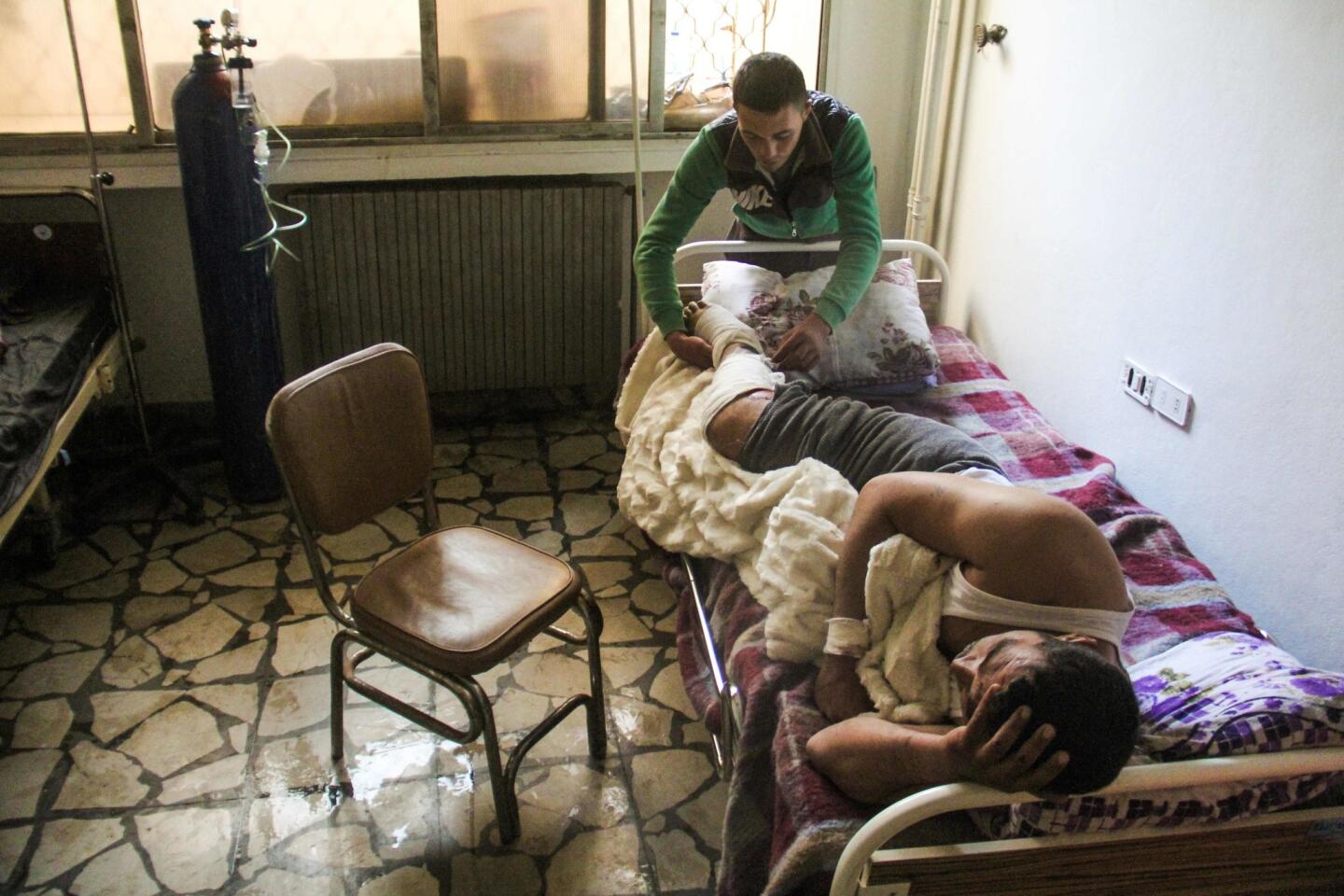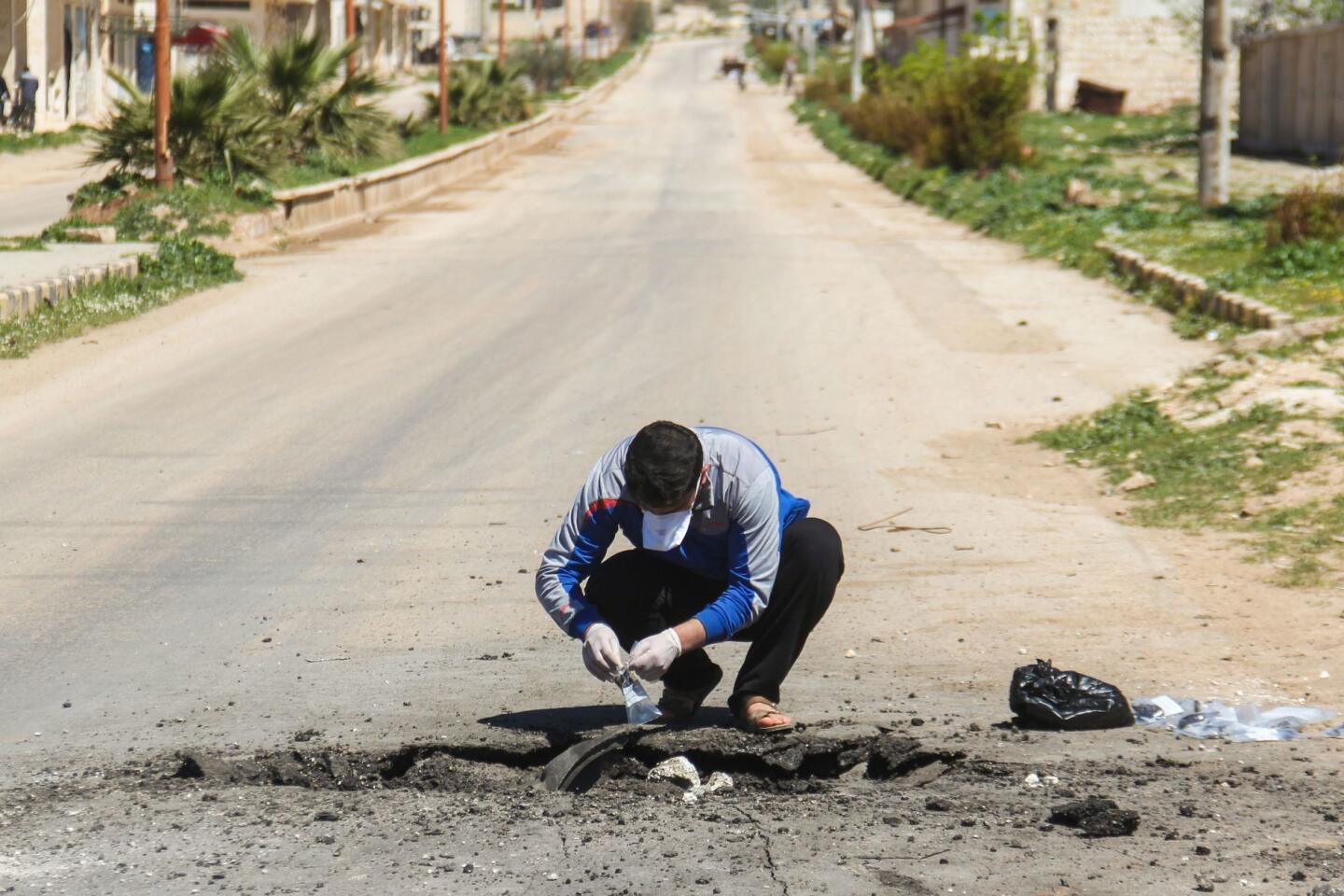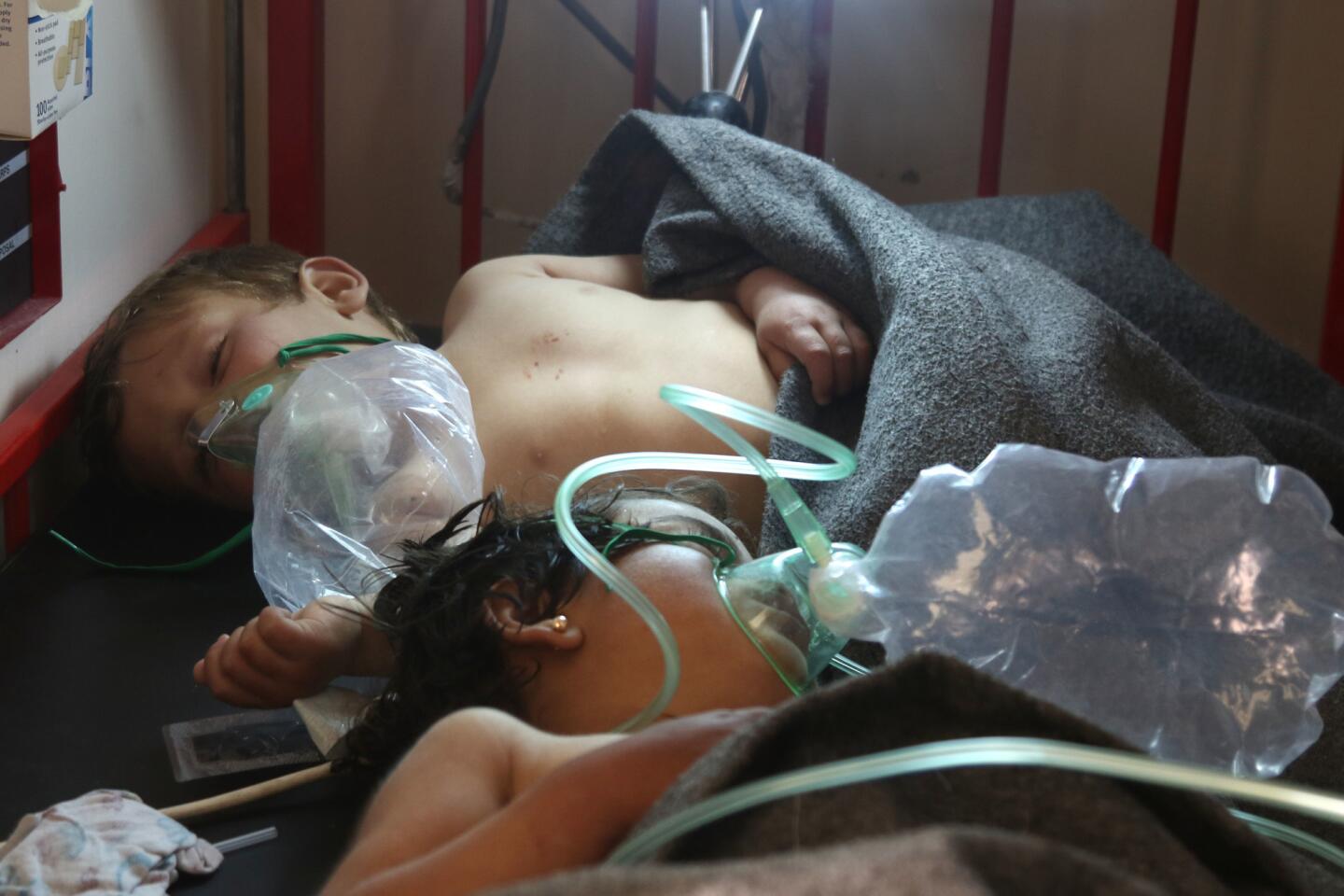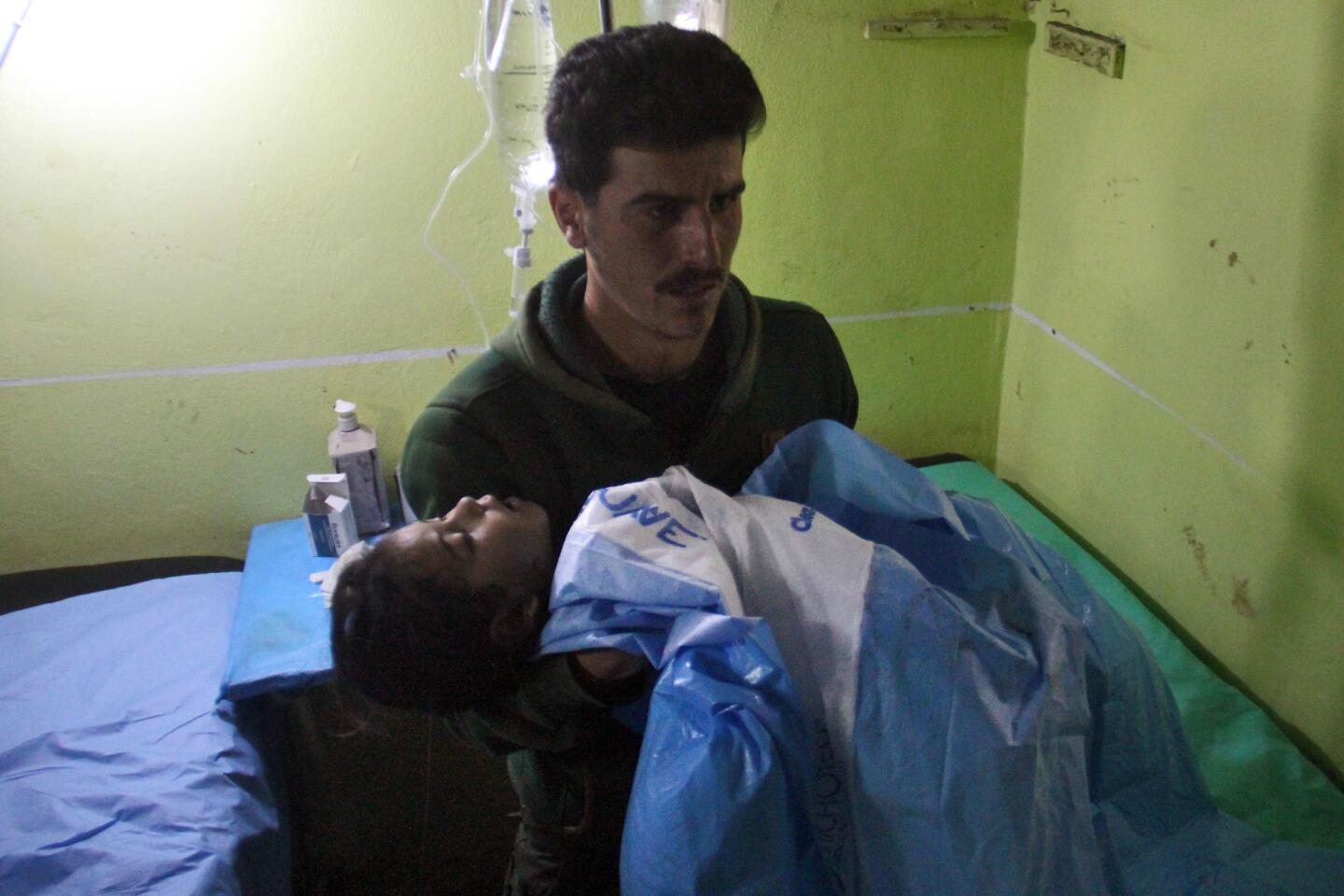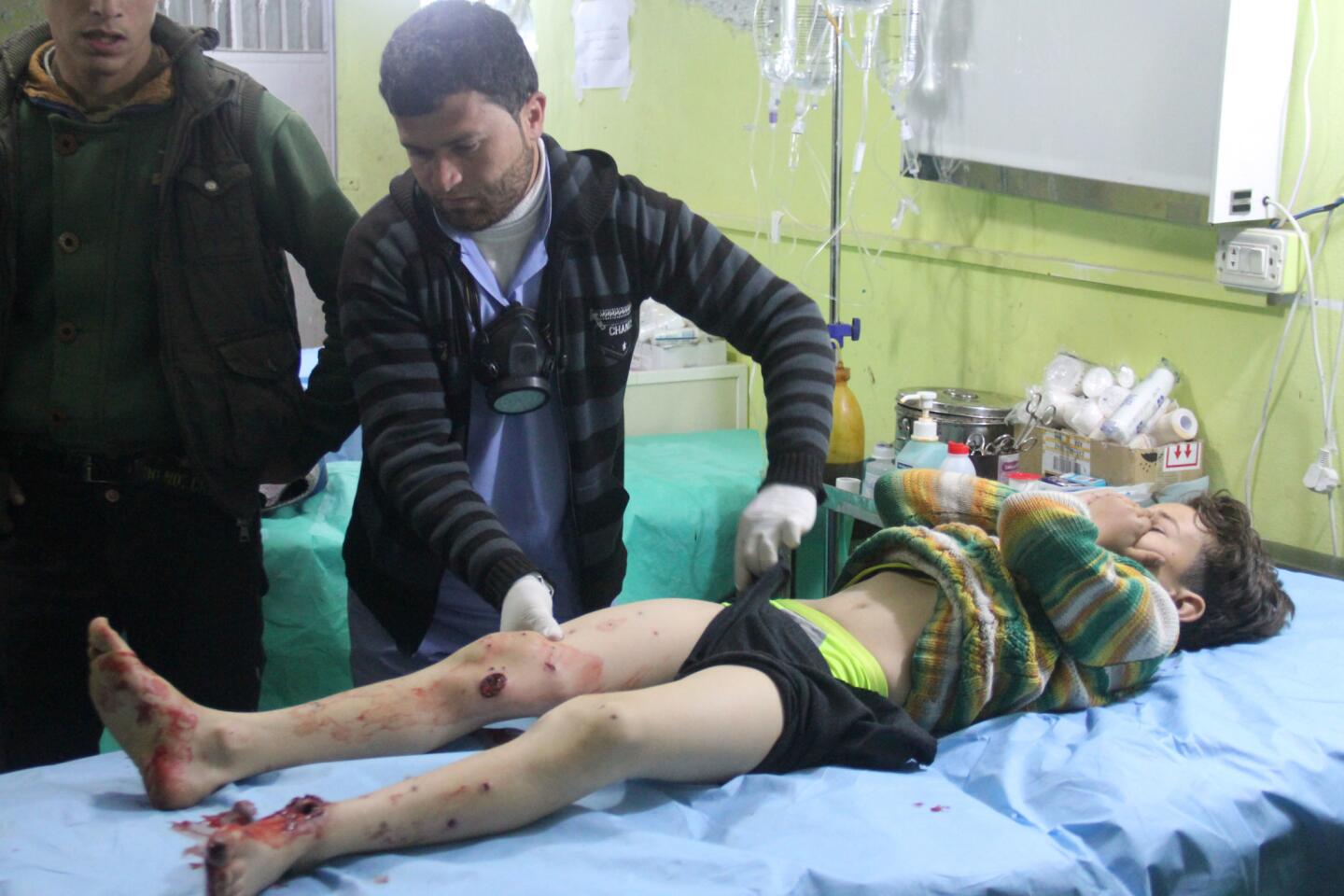U.S. condemns suspected Syrian chemical attack on civilians, but says the Assad government is a ‘political reality’

A suspected chemical attack in Syria’s northern Idlib province killed dozens of people on Tuesday, Syrian opposition activists said, describing the attack as among the worst in the country’s six-year civil war.
- Share via
Reporting from BEIRUT — The U.S. and its allies accused the government of Syrian President Bashar Assad of a poison gas attack Tuesday that killed dozens of people and injured scores more in a northwestern province controlled by rebels — an action which, if confirmed, would mark a startling atrocity even in the blood-soaked history of that country’s civil war.
The attack appeared to involve the use of sarin, a powerful nerve gas, said a U.S. official who was not authorized to be quoted by name discussing the issue.
Some activists and monitoring groups placed the death toll at 70 to 100. Several reported that airstrikes had targeted clinics treating the wounded.
President Trump in a statement called the attack “reprehensible” and said it “cannot be ignored by the civilized world.”
But he immediately focused blame on his predecessor, saying the “heinous actions” of the Assad government were a consequence of President Obama’s “weakness and irresolution” when he failed to enforce his own “red line” against chemical attacks in 2013.
At the same time, administration officials made clear that the president and his advisors were not reconsidering their decision, revealed just days ago, to accept Assad’s continued hold on power.
“It’s a political reality,” White House Press Secretary Sean Spicer told reporters when asked about the administration’s willingness to accept Assad’s continued rule.
White House says ‘reprehensible’ gas attack in Syria resulted from President Obama’s ‘red line’ »
The Syrian Observatory for Human Rights, a pro-opposition monitoring group with a network of activists in Syria, said medical crews had treated victims of suffocation whose symptoms, including shrunken irises, paleness and spasms, indicated poison gas. The group said medical crews reported that at least 58 people were killed.
Syria officially denied using a chemical weapon, as it did in the 2013 attacks.
In a statement, the Syrians said that “armed terrorist groups,” as the government labels opposition organizations, had falsely accused the military of using chemical weapons.
“The General Command of the Syrian army and armed forces absolutely denies the use of any chemical or poisonous materials … today, just as it has not and will not use them any place or anywhere, neither in the past nor in the future,” the statement said.
A spokesman for the Russian Defense Ministry pinned the blame early Wednesday on the rebels.
“The Syrian aviation carried out an airstrike on the eastern outskirts of Khan Sheikhoun, targeting a major ammunition storage facility of terrorists and a cluster of military hardware,” said Maj. Gen Igor Konashenkov, according to a report by Russian state news operator TASS. “The territory of this storage facility housed workshops to produce projectiles stuffed with toxic agents.”
The attack came just days after the Trump administration had walked away from previous U.S. policy that had called for Assad to leave office. That change in U.S. policy, along with the president’s warm comments on Monday to Egyptian President Abdel Fattah Sisi, had appeared to signal the new administration’s willingness to work with — or at least tolerate — Middle Eastern dictators in its pursuit of other objectives.
The attack underscored the risks inherent in any such policy.
It was not immediately clear how, or whether, the U.S. would respond to the incident. Trump is “extremely alarmed at these revelations” of a chemical attack, Spicer said, adding that the president was consulting with his national security advisors about a response.
But, he added, “there is not a fundamental option of regime change” in Syria.
On that point, at least, the U.S. appeared to be out of step with some allied governments. British Prime Minister Theresa May, in condemning the attack, said “I’m very clear that there can be no future for Assad in a stable Syria which is representative of all the Syrian people.”
The attack and the responses underscored that devising a policy toward Syria is likely to prove no easier for the new administration than it was for the last one.
Obama tried to balance two objectives — pushing Assad from power while simultaneously fighting Islamic State militants, who control parts of Syria and Iraq. He and his aides argued that Assad’s effort to suppress any opposition to his government was driving Syrians, especially those from Sunni Muslim communities, toward alliance with the militants.
But Obama’s efforts were notably unsuccessful. In 2012, he declared that use of chemical weapons by the Syrian government would cross a “red line.” A little more than a year later, he declined to order airstrikes against Assad’s forces despite clear evidence that they had launched a chemical attack on civilians. The incident was one of the most heavily criticized chapters of Obama’s presidency.
Trump, during his presidential campaign and since, has said that the U.S. should focus on the fight against Islamic State and not try to pursue two objectives at once. He has also sought better relations with Russia, which views Assad’s government as a necessary bulwark against escalating instability in the region.
If Tuesday’s attack was a deliberate use of chemical weapons by Assad’s forces, it would undermine Trump’s hopes that a hands-off policy toward Assad might mute the region’s turmoil.
In a statement, Secretary of State Rex Tillerson said that the attack makes “clear that this is how Bashar al Assad operates: with brutal, unabashed barbarism.”
“Those who defend and support him, including Russia and Iran, should have no illusions about Assad or his intentions. Anyone who uses chemical weapons to attack his own people shows a fundamental disregard for human decency and must be held accountable,” the statement said.
It is clear there is no hope for real peace in Syria until Assad is held accountable.
— Rep. Ed Royce (R-Fullerton)
Nikki Haley, the U.S. ambassador to the United Nations, called an emergency meeting of the Security Council on Wednesday to discuss what she called “the terrible chemical weapons attack in Syria.”
Notably, however, the condemnations from both Trump and Tillerson came only in written form. Administration officials avoided on-camera condemnations. Earlier in the day, during a photo session with the visiting King Abdullah II of Jordan, reporters asked Tillerson about the Syrian attack. He walked away without responding.
Some Republicans who opposed Obama for not doing enough militarily to drive Assad out of power have also criticized Trump for appearing to acquiesce to Assad’s hold on power.
Sen. John McCain (R-Ariz.), chairman of the Senate Armed Services Committee, who has repeatedly called for a stronger U.S. military effort to oust Assad, said in a statement that “with President Obama’s ‘red line’ far in the rearview mirror, Assad believes he can commit war crimes with impunity.”
“The question that confronts the United States now is whether we will take any action to disabuse him of this murderous notion,” McCain said.
Rep. Ed Royce (R-Fullerton), the chair of the House Foreign Affairs Committee, called the evidence of a poison gas attack “sickening.”
“With more than 480,000 people killed by the regime, and 14 million driven from their homes, it is clear there is no hope for real peace in Syria until Assad is held accountable,” he said.
In Syria, doctors said the attack came as a result of an airstrike by warplanes on the town of Khan Sheikhoun in the northwestern province of Idlib.
Rami Abdul Rahman, director of the Syrian Observatory for Human Rights, said in a phone interview that his group had spoken to doctors treating casualties in a medical facility, but had not dispatched its own observers to the site of the airstrikes.
Idlib is the primary bastion of Syria’s embattled opposition, and has been the target of frequent attacks by Syrian and Russian warplanes.
Konashenkov, the Russian Defense Ministry spokesman, said in an interview with the Russia Today news channel that Russian warplanes had not conducted any strikes in the area.
Tuesday’s strikes, if confirmed to have been conducted with chemical weapons, would be the deadliest chemical weapons attack since the ones in August 2013 that almost brought on a U.S. airstrike. At that time, the U.S. and Syrian opposition groups accused forces loyal to Assad of lobbing sarin-filled shells at rebel-held enclaves near Damascus. More than 1,000 people were killed, according to U.S. estimates.
In the aftermath, a deal pushed through by Russia saw the government surrender its stockpiles of chemical weapons — including sarin and VX — to the United Nations.
The Organization for the Prohibition of Chemical Weapons says more than 95% of the government’s arsenal was eliminated (including more than 600 tons of sarin and mustard agents, which were destroyed in 2014) as a result of the agreement. But the group has confirmed instances of chemical attacks since then, primarily with chlorine gas, by government as well as rebel forces.
Ahmet Uzumcu, the director general of the organization, the U.N.-appointed body responsible for eliminating the government’s chemical weapons, said it had started a fact-finding mission that was “in the process of gathering and analyzing information from all available sources.”
The Syrian National Coalition, an opposition umbrella group, demanded in a statement that the U.N. Security Council take measures to “hold the Assad regime accountable” for “the horrific crime.”
Failure to do so, it said, “would be understood as a message blessing the regime for its actions.”
Social media were inundated with horrific videos and images of the victims of the attack.
One of the images depicts what appear to be the bodies of a dozen children tucked under a purple blanket. One girl’s face is a rictus of sadness, her eyes gazing lifelessly into the distance.
“May God have vengeance against the unjust … first of them the Arab rulers,” says a voice on a video as one man moves the head of a baby to face a camera. The baby too is dead.
Another image shows a man foaming at the mouth as he lies in the bed of a pickup truck.
Through more than six years of a relentless civil war, Assad, with help from Russia and Iran, has clung to power long enough to see his opposition enemies lose vital rebel “capitals” such as Homs. Last year his forces took back all of Aleppo, which was Syria’s second-largest city before the war.
More recently, the government has pushed reconciliation agreements with some rebel forces, including Islamist hard-liners allied with Al Qaeda, and it is close to completing an exchange that would allow about 8,000 people to leave two government-controlled towns that have been surrounded by rebel forces.
Special correspondent Bulos reported from Beirut and Times staff writers Hennigan and Lauter from Washington. Times staff writers Noah Bierman and Tracy Wilkinson in Washington contributed to this report.
ALSO
Trump administration stops disclosing troop deployments in Iraq and Syria
U.S. military denies airstrike hit mosque in Syria, following reports of dozens killed
Tillerson and Turks fail to agree on next moves in fight against Islamic State in Syria
UPDATES:
9:15 a.m.: This article was updated with additional Times reporting on Russia’s reaction.
April 5, 3:33 a.m.: Updated with Russian statement that a Syrian airstrike on a rebel arsenal released the toxic agents.
3:25 p.m.: This article was updated throughout with additional analysis.
1:15 p.m.: This article has been updated with a statement from President Trump and a statement by the Syrian military.
10:45 a.m.: This article has been updated with a State Department comment on the attack.
10:15 a.m.: This article has been updated with comments from the White House spokesman.
9:40 a.m.: This article has been updated throughout with Times reporting.
This article was originally published at 4:35 a.m. April 4.
More to Read
Sign up for Essential California
The most important California stories and recommendations in your inbox every morning.
You may occasionally receive promotional content from the Los Angeles Times.
